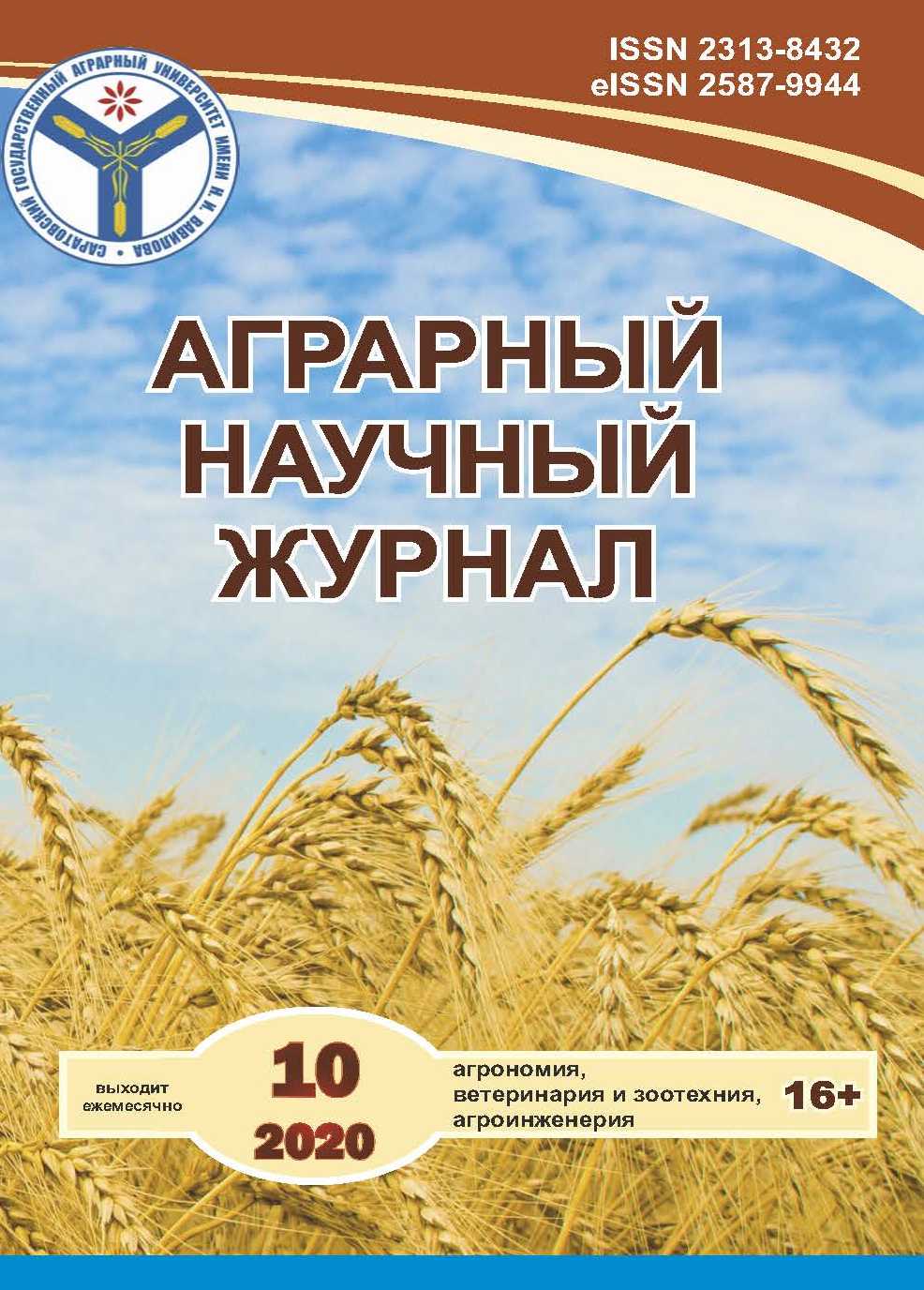The change of the intestinal microbiocenosis of chickens in the age aspect and the introduction of biologi-cally active substances
DOI:
https://doi.org/10.28983/asj.y2020i10pp81-86Keywords:
chickens, resident microflora, probiotic, enterosorbent, BAS combination, dynamicsAbstract
The article provides information on the species composition of the microflora of the digestive tract in chickens of the Dekalb cross, its changes during the period of early postembryonic development against the background of the introduction of biologically active substances. The assessment of the degree of influence of the use of monopreparations and their combinations is given. The study was carried out in 2020 at the Department of Obstetrics, Surgery and Non-communicable Animal Diseases of the Ivanovo State Agricultural Academy. The initial analysis of the microflora of the digestive tract was carried out in 5-day-old chickens. Chickens of experimental groups 2, 3 and 4 were injected with biologically active substances, respectively, probiotic Zoonorm at a dose of 0.2 g per head in the morning mixed with feed; a 0.3% suspension of an enterosorbent based on polymethylsiloxane polyhydrate was drunk 2 hours after the last feeding and a combination of two drugs at the appropriate time. The drugs were used for 20 days, the study of the composition of the intestinal microflora was carried out in 15- and 25-day-old chickens and 10 days after drug withdrawal. The results showed that during the critical period of development in the control and experimental groups of chickens there is a decrease in the number of intestinal residents. In control chickens, proliferation of Enterobacter cloacae is noted and the number of clostridia increases. Against the background of the probiotic, the number of lactobacilli, enterococci and E. coli (typical) increases and is restored. With the introduction of enterosorbent, the content of lactobacilli increases, proliferation of Enterobacter cloacae is absent throughout the experiment. The combination of probiotic and enterosorbent prevents the development of pathogens, stimulates the growth of lactobacilli, enterococci and stabilizes the amount of typical E. coli and bacteroids. Scientific novelty lies in the establishment of a regulating and stabilizing effect on the intestinal biome of a combination of probiotic and enterosorbent; elucidation of the metabolic and antagonistic function of bifidobacteria in chickens at an early stage of postembryonic development.
Downloads
References
Бельмер С.В., Малкоч А.В. Кишечная микрофлора и значение пребиотиков для ее функционирования // Лечащий врач. – 2006. – № 4. – С. 60–66.
Бондаренко В.М., Воробьев А.А. Дисбиозы и препараты с пробиотической функцией // Микробиология. – 2004. – № 1. – С. 84–92.
Бондаренко В.М., Мацулевич Т.В. Дисбактериоз кишечника как клинико-лабораторный синдром: современное состояние проблемы. Руководство для врачей. – М.: ГЭОТАР-Медиа, 2007. – 307 с.
Грозина А.А. Состав микрофлоры желудочно-кишечного тракта у цыплят-бройлеров при воздействии пробиотика и антибиотика (по данным T-RFLP–RT-PCR) // Сельскохозяйственная биология. – 2014. – № 6. – С. 46–58.
Здоровый микробиом кур / Г. Лаптев [и др.] // Ценовик. – 2018. – № 10. – С. 76–80.
Иванова Е.В. Роль бифидофлоры в ассоциативном симбиозе кишечной миробиоты человека: дис. …д-ра мед. наук. – Оренбург, 2018 – 295 с.
Исследование пристеночной микрофлоры кишечника крыс. / А.А. Воробьев [и др.] // Микробиология. – 2005. – № 3. – С. 61–65.
Колычев Н.М., Госманов Р.Г. Ветеринарная микробиология и микология. – СПб.: Лань, 2019. – 624 с.
Лазарева Т.С., Жвания Ф.Ф. Питание и иммунитет // Педиатрическая фармакология. – 2009. – Т. 6. – № 1. – С. 46–50.
Новокшенов А.А., Соколова Н.В. Физиологические функции лактобактерий в организме и эффективность их применения в составе пробиотиков в педиатрической практике // Эффективная фармакотерапия. – 2012. – № 53. – С. 52–57.
Фисинин В.И., Сурай П. Кишечный иммунитет у птиц: факты и размышления (обзор) // Сельскохозяйственная биология. – 2013. – № 4. – С. 3–25.
Функ И.А., Иркитова А.Н. Биотехнологический потенциал бифидобактерий // Acta biologica Sibirica. – 2016. – № 2(4). – С. 67–79.
Хавкин А.И. Микробиоценоз кишечника и иммунитет // РМЖ. – 2003, Т. 11. – № 3. – С. 3–7.
Cryan J.F. & Dinan T.G. Mind-altering microorganisms: the impact of the gut microbiota on brain and behaviour. Nat Rev Neurosci, 2012, 13: 701–712.
Pan D., Yu Z. Intestinal microbiome of poultry and its interaction with host and diet // Gut Microbes, 2014, Vol. 5, No.1, P. 108–119.
Perdigon G., Fuller R., Raya R. Lactic acid bacteria and their effect on the immune system//Curr. Intest. Microbiol., 2001, 2(1): 27–42.
Downloads
Published
Issue
Section
License
Copyright (c) 2020 The Agrarian Scientific Journal

This work is licensed under a Creative Commons Attribution-NonCommercial 4.0 International License.








